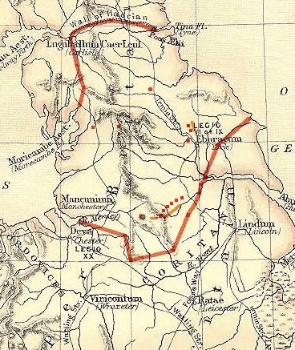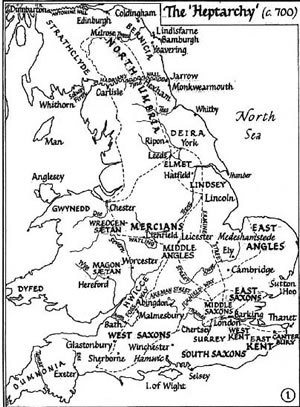Obviously Springhill as such didn’t exist in prehistoric and Roman times but the land was still here and there is evidence of human activity in Rossendale since the Mesolithic period of 8000-4000 BC. Findings dating before the Early Bronze Age (2500-750 BC) include some on Cribden and Cowpe Lowe. These are scanty and may reflect items dropped on routeways. More substantial finds, particularly involving burials, are mainly on the south-west fringes of the Rossendale area.
Tallis and McGuire studied pollen deposits in the Musbury area of Rossendale and have suggested that a range of types of vegetation where in existence by the end of the Bronze Age. These included undisturbed woodland (mainly oak, alder and hazel), secondary, degenerating woodland (largely birch), bracken-dominated areas, peat bogs and some emergent pastureland. They also describe some evidence of woodland clearance in the early Bronze Age and of the area being re-wooded in the Iron Age.
(Barraclough 'Prehistoric Lancashire' Slough, History Press 2008.
Early Settlements' left.
Tallis & McGuire, Journal Ecology 60:721-37. 1972)
Tallis and McGuire studied pollen deposits in the Musbury area of Rossendale and have suggested that a range of types of vegetation where in existence by the end of the Bronze Age. These included undisturbed woodland (mainly oak, alder and hazel), secondary, degenerating woodland (largely birch), bracken-dominated areas, peat bogs and some emergent pastureland. They also describe some evidence of woodland clearance in the early Bronze Age and of the area being re-wooded in the Iron Age.
(Barraclough 'Prehistoric Lancashire' Slough, History Press 2008.
Early Settlements' left.
Tallis & McGuire, Journal Ecology 60:721-37. 1972)
Iron Age (750 BC - 79AD)
Iron Age finds include some in Cowpe of cow horn and implement relating to agriculture, suggesting some degree of settlement.
At this time, just before the Roman occupation, the North West was settled by the Briganti. These are thought to be named after and to have worshipped Brigantia (Brigit, Bride).
The Briganti are said to have revolted against Roman occupation in AD 47 and again in AD 55-56 and 69-70 under Venutius. They were partially subdued by Petillius Cerialis in AD 71-4 and finally by Agricola in AD 79. The map shows the border of Brigantia in AD 69.
(Roman British Organisation, Brigantes Nation)
Iron Age finds include some in Cowpe of cow horn and implement relating to agriculture, suggesting some degree of settlement.
At this time, just before the Roman occupation, the North West was settled by the Briganti. These are thought to be named after and to have worshipped Brigantia (Brigit, Bride).
The Briganti are said to have revolted against Roman occupation in AD 47 and again in AD 55-56 and 69-70 under Venutius. They were partially subdued by Petillius Cerialis in AD 71-4 and finally by Agricola in AD 79. The map shows the border of Brigantia in AD 69.
(Roman British Organisation, Brigantes Nation)
Roman Britain (AD 79-410)
There is little evidence of Roman settlement in Rossendale: Roman roads crossed from Manchester to Ribchester and along the Ribble valley. There were also auxiliary forts at Manchester and Castleshaw.
(R. Thompson Watkin, Roman Lancashire, 1883, Roman Britain Organisation)
There is little evidence of Roman settlement in Rossendale: Roman roads crossed from Manchester to Ribchester and along the Ribble valley. There were also auxiliary forts at Manchester and Castleshaw.
(R. Thompson Watkin, Roman Lancashire, 1883, Roman Britain Organisation)
British, Saxon and Scandinavian period (AD 410-1066)
The Angles, Saxons and Jutes harassed Britain sporadically from 365 AD with a severe raid in 410 and the fall of Britain to the Saxons between 441-449 AD. In Lancashire, the main tribe was the Cumbri and in the late 5th century King Rheged's rule extended from Scotland through Cumbria to the Ribble. These lands were later incorporated into Northumbria with land south of the Mersy in Mercia and land between being fluidly held. The situation at AD 700 is summarised in the map on the left.
During this period, conversion to Christianity occurred during the 7th century, with St Cuthbert having a ministry in Cartmel. England developed a national identity and English emerged as a written language.
Viking raids started in AD 793 and concentrated on the north and west of England in the first half of the 9th century. Danelaw was established at the treaty of Wedmore in 878 with Lancashire being subject (perhaps insecurely) to Danelaw.
Further Norse excursions in the early 10th century into Lancashire and Cumbria from Ireland and the Western Isles led to the area being under Norse control. The situation remained fluid and at the time of the Norman Conquest there were three powerful earldoms: Wessex, Mercia and Northrumbria.
(Anglo-Saxons.net)
The Angles, Saxons and Jutes harassed Britain sporadically from 365 AD with a severe raid in 410 and the fall of Britain to the Saxons between 441-449 AD. In Lancashire, the main tribe was the Cumbri and in the late 5th century King Rheged's rule extended from Scotland through Cumbria to the Ribble. These lands were later incorporated into Northumbria with land south of the Mersy in Mercia and land between being fluidly held. The situation at AD 700 is summarised in the map on the left.
During this period, conversion to Christianity occurred during the 7th century, with St Cuthbert having a ministry in Cartmel. England developed a national identity and English emerged as a written language.
Viking raids started in AD 793 and concentrated on the north and west of England in the first half of the 9th century. Danelaw was established at the treaty of Wedmore in 878 with Lancashire being subject (perhaps insecurely) to Danelaw.
Further Norse excursions in the early 10th century into Lancashire and Cumbria from Ireland and the Western Isles led to the area being under Norse control. The situation remained fluid and at the time of the Norman Conquest there were three powerful earldoms: Wessex, Mercia and Northrumbria.
(Anglo-Saxons.net)






